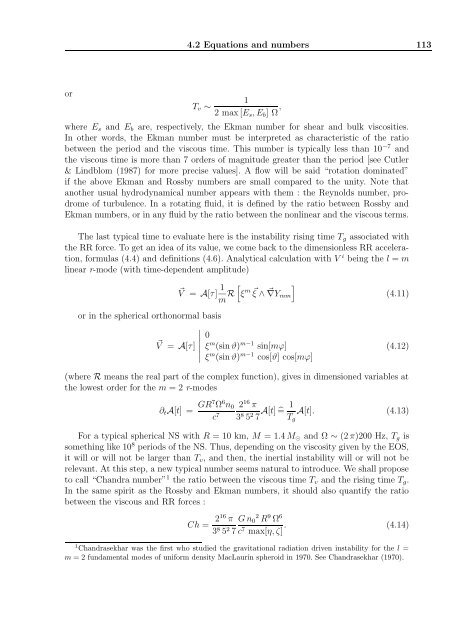Ecole doctorale de Physique de la région Parisienne (ED107)
Ecole doctorale de Physique de la région Parisienne (ED107)
Ecole doctorale de Physique de la région Parisienne (ED107)
Create successful ePaper yourself
Turn your PDF publications into a flip-book with our unique Google optimized e-Paper software.
or<br />
4.2 Equations and numbers 113<br />
Tv ∼<br />
1<br />
2 max [Es, Eb] Ω ,<br />
where Es and Eb are, respectively, the Ekman number for shear and bulk viscosities.<br />
In other words, the Ekman number must be interpreted as characteristic of the ratio<br />
between the period and the viscous time. This number is typically less than 10 −7 and<br />
the viscous time is more than 7 or<strong>de</strong>rs of magnitu<strong>de</strong> greater than the period [see Cutler<br />
& Lindblom (1987) for more precise values]. A flow will be said “rotation dominated”<br />
if the above Ekman and Rossby numbers are small compared to the unity. Note that<br />
another usual hydrodynamical number appears with them : the Reynolds number, prodrome<br />
of turbulence. In a rotating fluid, it is <strong>de</strong>fined by the ratio between Rossby and<br />
Ekman numbers, or in any fluid by the ratio between the nonlinear and the viscous terms.<br />
The <strong>la</strong>st typical time to evaluate here is the instability rising time Tg associated with<br />
the RR force. To get an i<strong>de</strong>a of its value, we come back to the dimensionless RR acceleration,<br />
formu<strong>la</strong>s (4.4) and <strong>de</strong>finitions (4.6). Analytical calcu<strong>la</strong>tion with V i being the l = m<br />
linear r-mo<strong>de</strong> (with time-<strong>de</strong>pen<strong>de</strong>nt amplitu<strong>de</strong>)<br />
or in the spherical orthonormal basis<br />
<br />
<br />
<br />
V = A[τ] <br />
<br />
<br />
V = A[τ] 1<br />
m R<br />
<br />
ξ m <br />
ξ ∧ ∇Ymm<br />
<br />
0<br />
ξ m (sin ϑ) m−1 sin[mϕ]<br />
ξ m (sin ϑ) m−1 cos[ϑ] cos[mϕ]<br />
(4.11)<br />
(4.12)<br />
(where R means the real part of the complex function), gives in dimensioned variables at<br />
the lowest or<strong>de</strong>r for the m = 2 r-mo<strong>de</strong>s<br />
∂tA[t] = GR7 Ω 6 n0<br />
c 7<br />
216 π<br />
38 52 1<br />
A[t] = A[t]. (4.13)<br />
7 Tg<br />
For a typical spherical NS with R = 10 km, M = 1.4 M⊙ and Ω ∼ (2 π)200 Hz, Tg is<br />
something like 10 8 periods of the NS. Thus, <strong>de</strong>pending on the viscosity given by the EOS,<br />
it will or will not be <strong>la</strong>rger than Tv, and then, the inertial instability will or will not be<br />
relevant. At this step, a new typical number seems natural to introduce. We shall propose<br />
to call “Chandra number” 1 the ratio between the viscous time Tv and the rising time Tg.<br />
In the same spirit as the Rossby and Ekman numbers, it should also quantify the ratio<br />
between the viscous and RR forces :<br />
Ch = 216 π<br />
38 52 G n0<br />
7<br />
2 R9 Ω6 c7 max[η, ζ]<br />
. (4.14)<br />
1 Chandrasekhar was the first who studied the gravitational radiation driven instability for the l =<br />
m = 2 fundamental mo<strong>de</strong>s of uniform <strong>de</strong>nsity MacLaurin spheroid in 1970. See Chandrasekhar (1970).
















